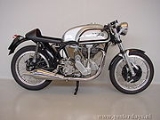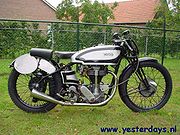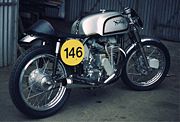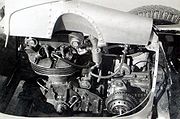
Norton Manx
Encyclopedia
The Norton Manx or Manx Norton is a British racing motorcycle
that was made from 1947 to 1962 by Norton Motors Ltd. A Norton had contested every Isle of Man TT
race from the inaugural 1907 event through into the 1970s, a feat unrivalled by any other manufacturer, and the development and honing of the Manx racing motorcycle was another step in this racing achievement.
New Manx Nortons, built to various specifications are still available to buy new, from various suppliers around the world. These suit different categories and definitions of Classic Motorcycle Racing and Historic Motorcycle Racing in different countries around the world.
Appearing just after the war, the 1947 Manx Norton was a lightly redesigned prewar racing Norton International
, an overhead cam single cylinder. The Norton factory race bikes under Joe Craig were the experimental models, and a customer version was available to buy from the factory in Bracebridge Street - to selected customers. Fitted with the McCandless brothers Featherbed frame
for 1950, the Manx gained a new lease of racing life as a racing machine, the new frame giving the fine steering necessary for high speed navigation of some very fast racing circuits of the time.
The last Bracebridge Street (the original home of Norton) Manx Nortons were sold in 1963. Even though Norton had pulled out of International Grand Prix racing in 1954, the Manx had become the backbone of privateer racing. The Classic Motorcycle Racing movement from the 1970s onwards has seen relatively large numbers of Manxs return to the track, and a flourishing supply of parts and services has appeared all around the world to nourish this demand.
 The Norton Manx was developed to win the Isle of Man TT from single overhead cam international racers by Norton racing team engineer Joe Craig. The double overhead cam configuration was developed in 1937 and after many problems perfected one year later. The Manx was delayed by the outbreak of World War II
The Norton Manx was developed to win the Isle of Man TT from single overhead cam international racers by Norton racing team engineer Joe Craig. The double overhead cam configuration was developed in 1937 and after many problems perfected one year later. The Manx was delayed by the outbreak of World War II
but reemerged for the 1946 Manx Grand Prix
. The motorcycle was upgraded with new telescopic forks and in 1948 gained twin leading shoe brakes. In 1950 the innovative Featherbed frame
was developed, giving the Manx a significant competitive advantage through a low centre of gravity and short wheelbase that was perfectly suited the challenging island TT course
. The all-welded, tubular featherbed frame was light and trim, without the usual forgings that added unnecessary weight. In 1950, the featherbed Manx recorded a double hat-trick of podium positions at the TT.
 The Manx engine was redesigned in 1953 with a much shorter stroke of 86 millimetre to improve the rev range.
The Manx engine was redesigned in 1953 with a much shorter stroke of 86 millimetre to improve the rev range.
The major 1954 upgrade to the Manx was to have been a laid-down engine design, with lower centre of gravity – along the lines of the Moto Guzzi
and Benelli racers. However, a decline in sales in the mid 1950s prompted a number of manufacturers to withdraw from GP racing in 1954, and Nortons did likewise. The Norton F Type Manx, as it was to have been, still exists, and restored is displayed in the Sammy Millers Museum Collection.
With Nortons withdrawal from racing, Joe Craig retired after more than 25 years of coaxing ever more power and reliability from his single cylinder Cammy racers.
worked with frame specialist Ron Hankins and engine tuner Ray Petty to develop a Manx Norton motocross
motorcycle. The double-overhead-cam, short-stroke Norton Manx road racing
engine was fitted into a Hankins frame and finished with an aluminium tank and titanium axles. The Manx MX was successful, winning the 1956 F.I.M.
500 cc European Motocross Championship, but was not able to compete with the emerging two-stroke bikes.
 Manx Nortons also played a significant role in the development of post war car racing. At the end of 1950, the English national 500 cc regulations were adopted as the new Formula 3. The JAP Speedway engine had dominated the category initially but the Manx was capable of producing significantly more power and became the engine of choice. Many complete motorcycles were bought in order to strip the engine for 500 cc car racing, as Norton would not sell separate engines. Manx rolling chassis were frequently sold on and paired with Triumph 500 cc twin engines to create Triton
Manx Nortons also played a significant role in the development of post war car racing. At the end of 1950, the English national 500 cc regulations were adopted as the new Formula 3. The JAP Speedway engine had dominated the category initially but the Manx was capable of producing significantly more power and became the engine of choice. Many complete motorcycles were bought in order to strip the engine for 500 cc car racing, as Norton would not sell separate engines. Manx rolling chassis were frequently sold on and paired with Triumph 500 cc twin engines to create Triton
cafe racers.
in London. Forty two Manx Nortons were produced between November 1962 and January 1963. In 1966 Colin Seeley
purchased what remained of the spares and tools, which he eventually sold on to John Tickle in 1969. John Tickle took over the Manx name when Norton ceased production and acquired a large quantity of spare parts. He also manufactured complete racers, called the Manx T5 (500) and T3 (350). Both used the short-stroke Manx engines in a frame designed by Tickle but he could not compete against the Japanese racers and sold his stock and the rights in the late 1970s.
Motorcycle
A motorcycle is a single-track, two-wheeled motor vehicle. Motorcycles vary considerably depending on the task for which they are designed, such as long distance travel, navigating congested urban traffic, cruising, sport and racing, or off-road conditions.Motorcycles are one of the most...
that was made from 1947 to 1962 by Norton Motors Ltd. A Norton had contested every Isle of Man TT
Isle of Man TT
The International Isle of Man TT Race is a motorcycle racing event held on the Isle of Man and was for many years the most prestigious motorcycle race in the world...
race from the inaugural 1907 event through into the 1970s, a feat unrivalled by any other manufacturer, and the development and honing of the Manx racing motorcycle was another step in this racing achievement.
New Manx Nortons, built to various specifications are still available to buy new, from various suppliers around the world. These suit different categories and definitions of Classic Motorcycle Racing and Historic Motorcycle Racing in different countries around the world.
Appearing just after the war, the 1947 Manx Norton was a lightly redesigned prewar racing Norton International
Norton International
The Norton International or Cammy Norton was a Norton Motors Ltd overhead cam motorcycle between 1931 and 1957.More than a TT replica sports roadster, the OHC Model 30, was 500 cc and the OHC Model 40 was 350 cc. During the 1930s it could be ordered from the Norton factory with all...
, an overhead cam single cylinder. The Norton factory race bikes under Joe Craig were the experimental models, and a customer version was available to buy from the factory in Bracebridge Street - to selected customers. Fitted with the McCandless brothers Featherbed frame
Featherbed frame
The featherbed frame was a motorcycle frame developed by the British Norton motorcycle company to improve the performance of their racing motorcycles around the twisting and demanding Isle of Man TT course in 1950. It was considered revolutionary at the time, and the best handling frame that a...
for 1950, the Manx gained a new lease of racing life as a racing machine, the new frame giving the fine steering necessary for high speed navigation of some very fast racing circuits of the time.
The last Bracebridge Street (the original home of Norton) Manx Nortons were sold in 1963. Even though Norton had pulled out of International Grand Prix racing in 1954, the Manx had become the backbone of privateer racing. The Classic Motorcycle Racing movement from the 1970s onwards has seen relatively large numbers of Manxs return to the track, and a flourishing supply of parts and services has appeared all around the world to nourish this demand.
Development

World War II
World War II, or the Second World War , was a global conflict lasting from 1939 to 1945, involving most of the world's nations—including all of the great powers—eventually forming two opposing military alliances: the Allies and the Axis...
but reemerged for the 1946 Manx Grand Prix
Manx Grand Prix
The Manx Grand Prix motorcycle races are held on the Isle of Man TT Course every year for a two-week period usually spanning the end of August and early September. The 'MGP' or 'Manx' is considered to be the amateur riders' alternative to the Isle of Man TT Races held in May and June...
. The motorcycle was upgraded with new telescopic forks and in 1948 gained twin leading shoe brakes. In 1950 the innovative Featherbed frame
Featherbed frame
The featherbed frame was a motorcycle frame developed by the British Norton motorcycle company to improve the performance of their racing motorcycles around the twisting and demanding Isle of Man TT course in 1950. It was considered revolutionary at the time, and the best handling frame that a...
was developed, giving the Manx a significant competitive advantage through a low centre of gravity and short wheelbase that was perfectly suited the challenging island TT course
Snaefell mountain course
Snaefell Mountain Course or Mountain Course is a road-racing circuit used for the Isle of Man TT and Manx Grand Prix Races held in the Isle of Man from 1911 and 1923 respectively. The racing is held on public roads closed for racing by an Act of Tynwald...
. The all-welded, tubular featherbed frame was light and trim, without the usual forgings that added unnecessary weight. In 1950, the featherbed Manx recorded a double hat-trick of podium positions at the TT.

The major 1954 upgrade to the Manx was to have been a laid-down engine design, with lower centre of gravity – along the lines of the Moto Guzzi
Moto Guzzi
Moto Guzzi is an Italian motorcycle manufacturer. It is one of seven brands owned by Piaggio.Established in 1921 in Mandello del Lario, Italy, the company is noted for its central historic role in Italy's motorcycling manufacture, its prominence worldwide in motorcycle racing, and a series of...
and Benelli racers. However, a decline in sales in the mid 1950s prompted a number of manufacturers to withdraw from GP racing in 1954, and Nortons did likewise. The Norton F Type Manx, as it was to have been, still exists, and restored is displayed in the Sammy Millers Museum Collection.
Sammy Miller Motorcycle museum
The Sammy Miller Motorcycle Museum was set up in 1964, after the former championship winning trials rider Sammy Miller set up a parts business in New Milton, Hampshire, England....
With Nortons withdrawal from racing, Joe Craig retired after more than 25 years of coaxing ever more power and reliability from his single cylinder Cammy racers.
Les Archer Norton Manx MX
British racer Les Archer, Jr.Les Archer, Jr.
Les Archer was a leading motorcycle racer of the 1950s, competing in long distance speed trials, road racing and scrambles, now known as motocross...
worked with frame specialist Ron Hankins and engine tuner Ray Petty to develop a Manx Norton motocross
Motocross
Motocross is a form of motorcycle sport or all-terrain vehicle racing held on enclosed off road circuits. It evolved from trials, and was called scrambles, and later motocross, combining the French moto with cross-country...
motorcycle. The double-overhead-cam, short-stroke Norton Manx road racing
Road racing
Road racing is a general term for most forms of motor racing held on paved, purpose-built race tracks , as opposed to oval tracks and off-road racing...
engine was fitted into a Hankins frame and finished with an aluminium tank and titanium axles. The Manx MX was successful, winning the 1956 F.I.M.
Fédération Internationale de Motocyclisme
The Fédération Internationale de Motocyclisme is the governing body of motorcycle racing. It represents 103 national motorcycle federations that are divided into six regional continental unions....
500 cc European Motocross Championship, but was not able to compete with the emerging two-stroke bikes.
Car racing

Triton motorcycle
The Triton was a modified café racer motorcycle of the 1960s-1970s. The name derives from a contraction of Triumph and Norton, the two brands of motorcycle combined.The intention was to combine the best elements of each to give a bike superior to both...
cafe racers.
Endings and beginnings
1962 was the last full year for the production Norton Manx. In July AMC announced the transfer of production from Bracebridge Street to WoolwichWoolwich
Woolwich is a district in south London, England, located in the London Borough of Greenwich. The area is identified in the London Plan as one of 35 major centres in Greater London.Woolwich formed part of Kent until 1889 when the County of London was created...
in London. Forty two Manx Nortons were produced between November 1962 and January 1963. In 1966 Colin Seeley
Colin Seeley
Colin Seeley is a former English motorcycle sidecar racer and, later became a successful motorcycle designer and constructor....
purchased what remained of the spares and tools, which he eventually sold on to John Tickle in 1969. John Tickle took over the Manx name when Norton ceased production and acquired a large quantity of spare parts. He also manufactured complete racers, called the Manx T5 (500) and T3 (350). Both used the short-stroke Manx engines in a frame designed by Tickle but he could not compete against the Japanese racers and sold his stock and the rights in the late 1970s.

